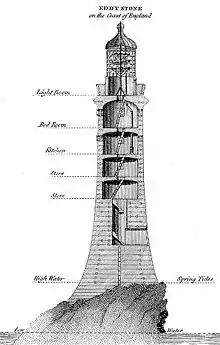Eddystone Lighthouse
The Eddystone Lighthouse is a lighthouse that is located on the dangerous Eddystone Rocks, 9 statute miles (14 km) south of Rame Head in England. While Rame Head is in Cornwall, the rocks are submerged below the surface of the sea [3] and composed of Precambrian gneiss.[4]
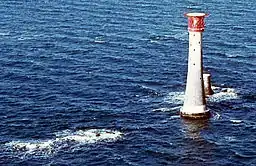 An aerial view of the fourth lighthouse.
(The stub of the third lighthouse is visible in the background.) | |
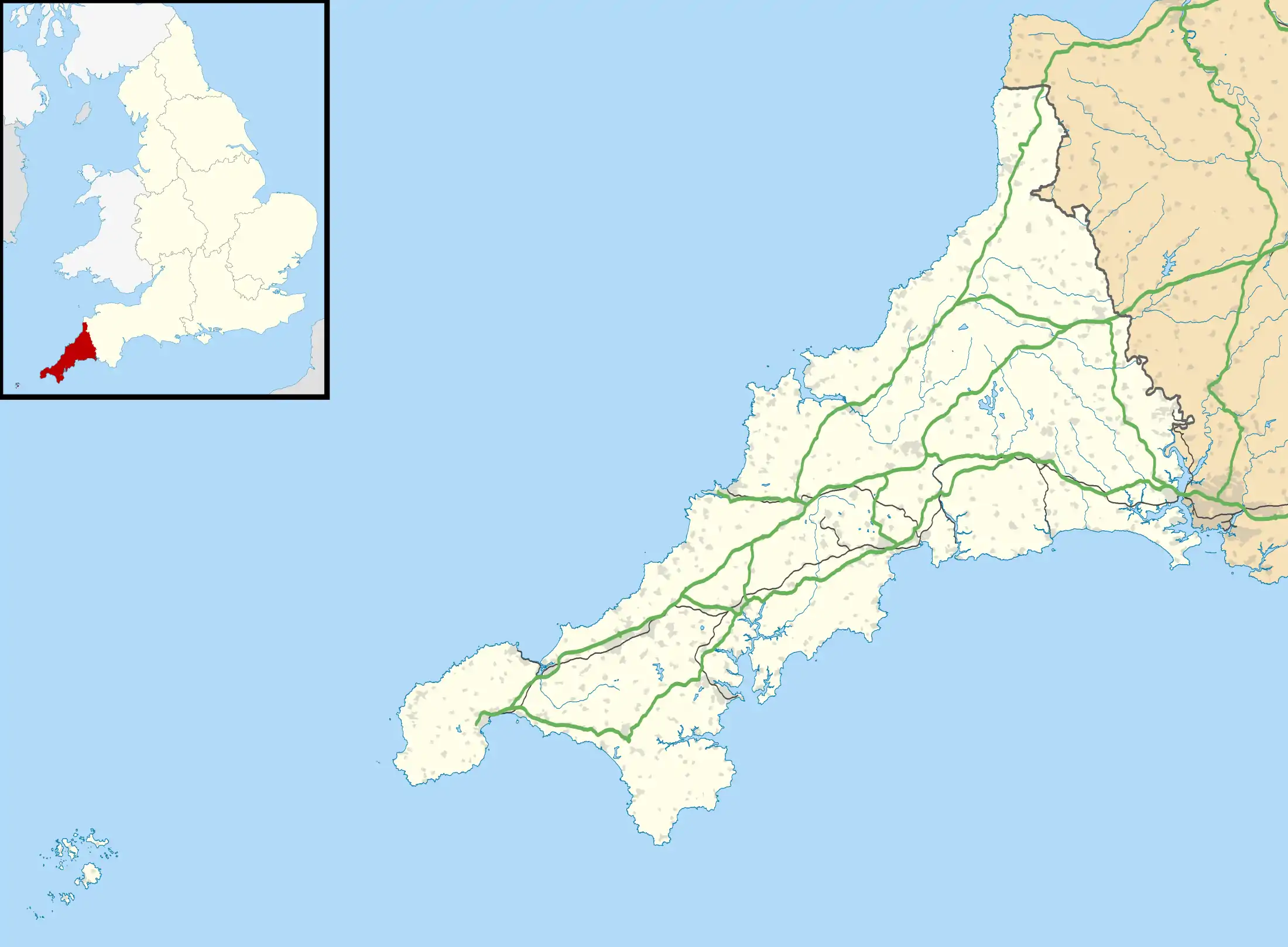 Cornwall | |

| |
| Location | offshore Rame Head Plymouth England |
|---|---|
| Coordinates | 50°10′48″N 04°15′54″W |
| Year first constructed | 1698 (first) 1709 (second) 1759 (third) |
| Year first lit | 1882 (current) |
| Automated | 1982 |
| Deactivated | 1703 (first) 1755 (second) 1877 (third) |
| Construction | wooden tower (first and second) granite tower (third and current) |
| Tower shape | octagonal tower (first) dodecagonal tower (second) tapered cylindrical tower (third) tapered cylindrical tower with lantern and helipad on the top (current) |
| Tower height | 18 metres (59 ft) (first) 21 metres (69 ft) (second) 22 metres (72 ft) (third) 49 metres (161 ft) (current) |
| Focal height | 41 metres (135 ft) |
| Current lens | 4th order 250 mm rotating |
| Light source | solar power |
| Intensity | 26,200 candela |
| Range | 17 nautical miles (31 km) |
| Characteristic | Fl (2) W 10s. Iso R 10s. at 28 metres (92 ft) focal height |
| Fog signal | one blast every 30s. |
| Racon | T |
| Admiralty number | A0098 |
| NGA number | 0132 |
| ARLHS number | ENG 039 |
| Managing agent | Trinity House [1] [2] |
The current structure is the fourth to be built on the site. The first and second were destroyed by storm and fire respectively. The third, also known as Smeaton's Tower, is the best known because of its influence on lighthouse design and its importance in the development of concrete for building. Its upper portions have been re-erected in Plymouth as a monument.[5] The first lighthouse, completed in 1699, was the world's first open ocean lighthouse, although the Cordouan Lighthouse off the western French coast preceded it as the first offshore lighthouse.[6]
The need for a light
The Eddystone Rocks are an extensive reef approximately 12 miles (19 km) SSW off Plymouth Sound, one of the most important naval harbours of England, and midway between Lizard Point, Cornwall and Start Point. They are submerged at high spring tides and were so feared by mariners entering the English Channel that they often hugged the coast of France to avoid the danger, which thus resulted not only in shipwrecks locally, but on the rocks of the north coast of France and the Channel Islands.[7] Given the difficulty of gaining a foothold on the rocks particularly in the predominant swell it was a long time before anyone attempted to place any warning on them.
Winstanley's lighthouse
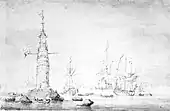
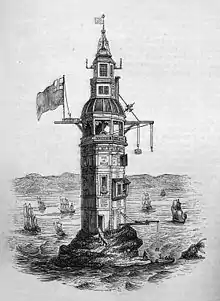
The first lighthouse on Eddystone Rocks was an octagonal wooden structure built by Henry Winstanley. The lighthouse was also the first recorded instance of an offshore lighthouse.[6] Construction started in 1696 and the light was lit on 14 November 1698. During construction, a French privateer took Winstanley prisoner and destroyed the work done so far on the foundations, causing Louis XIV to order Winstanley's release with the words "France is at war with England, not with humanity".[5][8]
The lighthouse survived its first winter but was in need of repair, and was subsequently changed to a dodecagonal (12 sided) stone clad exterior on a timber framed construction with an octagonal top section as can be seen in the later drawings or paintings. (This gives rise to the claims that there have been five lighthouses on Eddystone Rock.) The octagonal top section (or 'lantern') was 15 ft (4.6 m) high and 11 ft (3.4 m) in diameter, its eight windows each made up of 36 individual glass panes. It was lit by '60 candles at a time, besides a great hanging lamp'.[9]
Winstanley's tower lasted until the Great Storm of 1703 erased almost all trace on 27 November. Winstanley was on the lighthouse, completing additions to the structure. No trace was found of him, or of the other five men in the lighthouse.[10][11]
The cost of construction and five years' maintenance totalled £7,814 7s.6d, during which time dues totalling £4,721 19s.3d had been collected at one penny per ton from passing vessels.
Rudyard's lighthouse
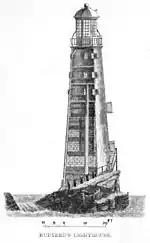
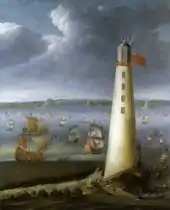
Following the destruction of the first lighthouse, Captain John Lovett[12][note 1] acquired the lease of the rock, and by Act of Parliament was allowed to charge passing ships a toll of one penny per ton. He commissioned John Rudyard (or Rudyerd) to design the new lighthouse, built as a conical wooden structure around a core of brick and concrete. The vertical wooden planks which sheathed the structure were installed by two master-shipwrights and caulked like those of a ship;[9] and the whole structure was anchored to the reef using thirty-six wrought iron bolts forged to fit deep holes which had been machine-cut in the reef.[13] A light was first shone from the tower on 28 July 1708[14] and the work was completed in 1709. The light was provided by 24 candles.[9] This proved more durable, surviving nearly fifty years.[5]

On the night of 2 December 1755, the top of the lantern caught fire, probably through a spark from one of the candles used to illuminate the light, or else through a fracture in the chimney which passed through the lantern from the stove in the kitchen below.[9] The three keepers threw water upwards from a bucket but were driven onto the rock and were rescued by boat as the tower burnt down. Keeper Henry Hall, who was 94 at the time, died several days later from ingesting molten lead from the lantern roof.[5] A report on this case was submitted to the Royal Society by physician Edward Spry,[15] and the piece of lead is now in the collections of the National Museums of Scotland.[16][17]
Smeaton's lighthouse
The third lighthouse marked a major step forward in the design of such structures.
Recommended by the Royal Society, civil engineer John Smeaton modelled the shape on an oak tree, the foundations and outside structure built of local Cornish granite, and lighter Portland limestone masonry used on the inside. He pioneered 'hydraulic lime', a concrete that cured under water, and developed a technique of securing the blocks using dovetail joints and marble dowels. Construction started in 1756 at Millbay[18] and the light was first lit on 16 October 1759.[5]
Smeaton's lighthouse was 59 feet (18 m) high and had a diameter at the base of 26 feet (8 m) and at the top of 17 feet (5 m). It was lit by a chandelier of 24 large tallow candles.[19]
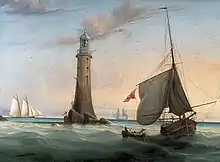
In 1807 the 100-year lease on the lighthouse expired, whereupon ownership and management devolved to Trinity House. In 1810 they replaced the chandelier and candles with 24 Argand lamps and parabolic reflectors.[19]
In 1841 major renovations were made,[20] under the direction of engineer Henry Norris of Messrs. Walker & Burges, including complete repointing, replacement water tanks and filling of a large cavity in the rock close to the foundations. In 1845 the lighthouse was equipped with a new second-order fixed catadioptric optic,[21] manufactured by Henry Lepaute of Paris, with a single multi-wick oil lamp, replacing the old lamps and reflectors.[22] This was the first time that a fully catadioptric large optic (using prisms rather than mirrors above and below the lens) had been constructed,[23] and the first such installation in any lighthouse.[24]
Smeaton's lighthouse remained in use until 1877 when erosion to the rocks under the lighthouse caused it to shake from side to side whenever large waves hit.[25] After decommissioning it was rebuilt on Plymouth Hoe, in Plymouth, as a memorial. William Tregarthen Douglass supervised the dismantling and removal of Smeaton's Tower.
The re-erected tower on the Hoe is now a tourist attraction. The foundations and stub of the tower remain, close to the new and more solid foundations of the current lighthouse[5] – the foundations proved too strong to be dismantled so the Victorians left them where they stood.
An 1850 replica of Smeaton's lighthouse, Hoad Monument, stands above the town of Ulverston, Cumbria as a memorial to naval administrator Sir John Barrow.
Douglass's lighthouse
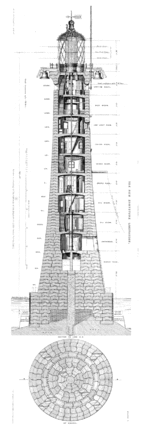
%252C_from-_The_Flags_of_the_World_Plate_24_(cropped).png.webp)
The current, fourth, lighthouse was designed by James Douglass, using Robert Stevenson's developments of Smeaton's techniques. By July 1878 the new site, on the South Rock was being prepared during the 3½ hours between ebb and flood tide; the foundation stone was laid on 19 August the following year by HRH The Duke of Edinburgh, Master of Trinity House.[26] The supply ship Hercules was based at Oreston, now a suburb of Plymouth; stone was prepared at the Oreston yard and supplied from the works of Messrs Shearer, Smith and Co of Wadebridge.[27][28] The tower, which is 49 metres (161 ft) high, contains a total of 62,133 cubic feet of granite, weighing 4,668 tons.[26] The last stone was laid on 1 June 1881 and the light was first lit on 18 May 1882. The lighthouse is still in use.
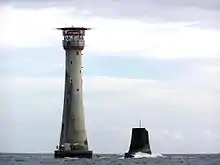
The lighthouse was equipped with a large (first-order) six-sided biform (i.e. two-tier) rotating optic, 12.5-foot (3.8 m) high in total, manufactured by Chance Brothers of Smethwick;[29] each of the six sides of the optic was divided into two Fresnel lens panels, which provided the light's characteristic of two flashes every thirty seconds.[30] In total, the apparatus stood over 10 feet (3.0 m) tall and weighed over seven tons.[31] At the time the Eddystone's extra-tall lenses were the largest in existence;[32] their superior height was achieved through the use of extra-dense flint glass in the upper and lower portions of each panel.[33] The lighthouse was equipped with a 0.5 h.p. caloric engine to drive the optic's rotation.[26] Illumination was provided by a pair of Douglass-designed six-wick concentric oil burners;[34] eighteen cisterns in the lower part of the tower were used to store up to 2,660 tons (nine months' worth) of colza oil to fuel the lamps.[35] On clear nights, only the lamp in the lower tier of lenses was lit (producing a light of 37,000 candlepower); in poor visibility, however (judged by whether the Plymouth Breakwater light was visible), both lamps were used at full power, to provide a 159,600 candlepower light.[31]
In addition to the main light a fixed white light was shone from a room on the eighth storey of the tower (using a pair of Argand lamps and reflectors) in the direction of the hazardous Hand Deeps.[36] The lighthouse was also provided with a pair of large bells, each weighing two tons, which were suspended from either side of the lantern gallery to serve as a fog signal. Ten years later they were supplemented (and then supplanted) by use of an explosive fog signal device.[37]
In 1904 the lamps were replaced with incandescent oil vapour burners.[30] Following the invention of the mercury bath system (allowing a lighthouse optic to revolve in a trough of mercury rather than on rollers) the Eddystone lens pedestal was duly upgraded and the drive mechanism replaced.[31] Later, in 1959 the light was electrified and the current smaller (fourth-order) 'bi-valve' optic was installed; at the same time a 'supertyfon' fog signal was installed, with compressors powered from the diesel generators.[37] The old optic was removed and donated to Southampton Maritime Museum (it was exhibited on the Royal Pier in the 1970s, but later removed to a council yard where it was destroyed by vandals).[31]
The lighthouse was automated in 1982, the first Trinity House 'Rock' (or offshore) lighthouse to be converted. Two years earlier the tower had been changed by construction of a helipad above the lantern, to allow maintenance crews access;[38] the helipad has a weight limit of 3600 kg. As part of the automation of the lighthouse a new electric fog signal was installed and a metal halide discharge lamp replaced the incandescent light bulb formerly in use. The light and other systems were monitored remotely, initially by Trinity House staff at the nearby Penlee Point fog signal station.[39] Since 1999 the lighthouse has run on solar power.[40]
Present day
The tower is 49 metres (161 ft) high, and its white light flashes twice every 10 seconds. The light is visible to 22 nautical miles (41 km), and is supplemented by a foghorn of 3 blasts every 62 seconds.[5] A subsidiary red sector light shines from a window in the tower to highlight the Hand Deeps hazard to the west-northwest. The lighthouse is now monitored and controlled from the Trinity House Operations Control Centre at Harwich in Essex.
References in media
- The lighthouse inspired a sea shanty, frequently recorded, that begins "My father was the keeper of the Eddystone light / And he slept with a mermaid one fine night / From this union there came three / A porpoise and a porgy and the other was me!".[41] Another version has the fourth line as "Two of them were fishes and the other was me." There are several verses.
- The lighthouse has been used as a metaphor for stability.[42]
- In the Goon Show episode Ten Snowballs that shook the World (1958), Neddie Seagoon is sent to Eddystone Lighthouse to warn the inhabitants that Sterling has dropped from F-sharp to E-flat.
- The lighthouse is celebrated in the opening and closing movements of Ron Goodwin's Drake 400 Suite. The movement's main theme was directly inspired by the lighthouse's unique light characteristic.[43]
- A novel based on the building of Smeaton's lighthouse, containing many details of the construction, was published in 2005.[44]
- The lighthouse is referenced twice in Herman Melville's epic novel Moby-Dick; at the beginning of Chapter 14, "Nantucket": "How it stands there, away off shore, more lonely than the Eddystone lighthouse.", and in Chapter 133, "The Chase – First Day": "So, in a gale, the but half baffled Channel billows only recoil from the base of the Eddystone, triumphantly to overleap its summit with their scud."
- The lighthouse is referred to in "Daddy was a Ballplayer" by the Canadian band Stringband, and follows a similar line to the sea shanty.
- "The Most Famous of All Lighthouses," the third chapter of The Story of Lighthouses (Norton 1965) by Mary Ellen Chase, is devoted to the Eddystone Lighthouse.
- Eddystone Lighthouse was used for many of the exterior shots in The Phantom Light, a 1935 film directed by Michael Powell.[45]
Tribute
On 14 November 2019, Google celebrated the 321st anniversary of the First Lighting of Eddystone Lighthouse with a Google Doodle.[46]
Gallery
 Clouds over Plymouth Hoe
Clouds over Plymouth Hoe
 Tinside Pool, Plymouth Sound
Tinside Pool, Plymouth Sound Sunlight through the lantern room
Sunlight through the lantern room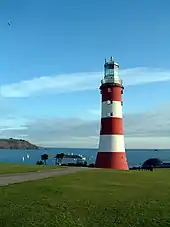 Smeaton's Lighthouse, now partially re-erected on Plymouth Hoe.
Smeaton's Lighthouse, now partially re-erected on Plymouth Hoe. Cross-section of Douglass's lighthouse in 1884
Cross-section of Douglass's lighthouse in 1884
See also
- List of lighthouses in England
- Eddystone, the Google Bluetooth Low Energy beacon
- Hook Lighthouse, second oldest lighthouse in the world and oldest in the British Isles
Notes
- Later Colonel John Lovett (c. 1660–1710) of Liscombe Park Buckinghamshire and Corfe, (son and heir of former merchant in Turkey, Christopher Lovett, lord mayor of Dublin 1676–1677) and uncle of noted architect Edward Lovett Pearce 1699–1733.
References
- Eddystone The Lighthouse Directory. University of North Carolina at Chapel Hill. Retrieved 30 April 2016
- Eddystone Lighthouse Trinity House. Retrieved 30 April 2016
- Ordnance Survey mapping; the rocks form part of the unitary district of the City of Plymouth, in the ceremonial county of Devon
- "Get A Map". Ordnance Survey. Retrieved 6 September 2006. View at 1:50000 scale
- "Eddystone history". Trinity House. Archived from the original on 8 November 2014. Retrieved 27 November 2014.
- "Lighthouse". Encyclopædia Britannica. Retrieved 5 July 2016.
- Smiles, Samuel (1861). The Lives of the Engineers. Vol 2. p. 16.
- 01: Winstanley’s Light (painting 1699 – 1703)
- Nancollas, Tom (2018). Seashaken Houses: A Lighthouse History from Eddystone to Fastnet. Particular Books. p. 108.
- "Eddystone Lighthouse History". Eddystone Tatler Ltd. Archived from the original on 2 May 2006. Retrieved 7 September 2006.
- "The Great Storm of 1703". BBC. Archived from the original on 30 August 2006. Retrieved 7 September 2006.
- Whyman, Susan E. (1999). Sociability and Power in Late-Stuart England: The Cultural Worlds of the ... Oxford University Press. p. 130. ISBN 978-0-19-925023-3.
- Contemporary illustrations with description by Rudyerd.
- Majdalany, Fred (1959). The Red Rocks of Eddystone. London: Longmans. p. 86.
- Spry, Edward; John Huxham (1755–56). "An Account of the Case of a Man Who Died of the Effects of the Fire at Eddy-Stone Light-House. By Mr. Edward Spry, Surgeon at Plymouth". Philosophical Transactions of the Royal Society. 49: 477–484. Bibcode:1755RSPT...49..477S. doi:10.1098/rstl.1755.0066. JSTOR 104958. S2CID 186209316.
- Palmer, Mike (2005). Eddystone: the Finger of Light (2nd ed.). Woodbridge, Suffolk: Seafarer Books. ISBN 0-9547062-0-X.
- Lighthouse, Eddystone, second / sample / lead www.nms.ac.uk, accessed 12 December 2019
- Langley, Martin (1987). Millbay Docks (Port of Plymouth series). Exeter: Devon Books. p. 2. ISBN 0-86114-806-1.
- Brewster, David (1832). The Edinburgh Encyclopaedia, vol. XII. Philadelphia: Joseph and Edward Parker. pp. 54–57.
- Woolmer's Exeter and Plymouth Gazette, 15 May 1841
- image
- "Lighthouse management : the report of the Royal Commissioners on Lights, Buoys, and Beacons, 1861, examined and refuted Vol. 2". p. 88.
- Elliot, George H. (1875). European Light-House Systems. London: Lockwood & co. p. 137. Retrieved 10 March 2019.
- Levitt, Theresa (2013). A Short Bright Flash: Augustin Fresnel and the Birth of the Modern Lighthouse. New York: W. W. Norton & co.
- Douglass, James Nicholas (1878). "Note on the Eddystone Lighthouse". Minutes of proceedings of the Institution of Civil Engineers. vol. 53, part 3. London: Institution of Civil Engineers. pp. 247–248.
- "Lighthouses". Encyclopaedia Britannica, 10th Edition. 30: 252. 1902. Retrieved 19 February 2020.
- "Commencement and Progress of the Eddystone". The Cornishman (40). 17 April 1879. p. 6.
- "The New Eddystone Lighthouse". The Cornishman (49). 19 June 1879. p. 3.
- image
- Encyclopaedia Britannica, 1911 edition, vol. 16, p. 650.
- Palmer, Mike (2005). Eddystone: The Finger of Light. Woodbridge, Suffolk: Seafarer Books. p. 123.
- Tag, Thomas. "Hyper-Radial Lenses". United States Lighthouse Society. Retrieved 25 January 2020.
- Chance, James Frederick (2018). A History of the Firm of Chance Brothers & Co. Sheffield, UK: Society of Glass Technology. p. 178.
- image
- Davenport Adams, W. H. (1891). The Story of our Lighthouses and Lightships: Descriptive and Historical (PDF). London, Edinburgh & New York: Thomas Nelson & Sons. pp. 111–116. Retrieved 27 February 2019.
- image
- Renton, Alan (2001). Lost Sounds: The Story of Coast Fog Signals. Caithness, Scotland: Whittles.
- "Eddystone Lighthouse". Trinity House. Retrieved 30 December 2015.
- Auld, Jack (21 July 1983). "Automation relieves the Eddystone keeper". New Scientist. 99 (1367): 213.
- Woodman, Richard; Wilson, Jane (2002). The Lighthouses of Trinity House. Bradford-on-Avon, Wilts.: Thomas Reed. p. 179.
- "The Eddystone Light". Retrieved 11 April 2008.
- Thomas D'Arcy McGee commented that Canada's foundations were as "strong as the foundations of Eddystone" in The Globe, 31 October 1864, 4.
- CD insert, "British Light Music: Ron Goodwin. 633 Squadron, Drake 400 Suite, and others. New Zealand Symphony Orchestra, Ron Goodwin, conductor." Marco Polo CD 8.223518
- Severn, Christopher (2005). Smeaton's Tower. Woodbridge, Suffolk: Seafarer Books. ISBN 0-9542750-9-8.
- "Beacons in the Dark: Lighthouse Iconography in Wartime British Cinema"
- "321st Anniversary of the First Lighting of Eddystone Lighthouse". Google. 14 November 2019.
Further reading
- Hart-Davis, Adam; Troscianko, Emily (2002). Henry Winstanley and the Eddystone Lighthouse. Stroud: Sutton Publishing. ISBN 0-7509-1835-7.
- John Smeaton (1793). A Narrative of the Building and Description of the Eddystone Lighthouse with Stone. London
- Palmer, Mike; Eddystone, The Finger of Light. Palmridge Publishing, 1998 – Revised edition, 2005 by Seafarer Books & Globe Pequot Press / Sheridan House ISBN 0-9547062-0-X
- Eddystone (2016). The Finger of Light, revised Kindle ebook edition
External links
| Wikimedia Commons has media related to Eddystone Light. |
